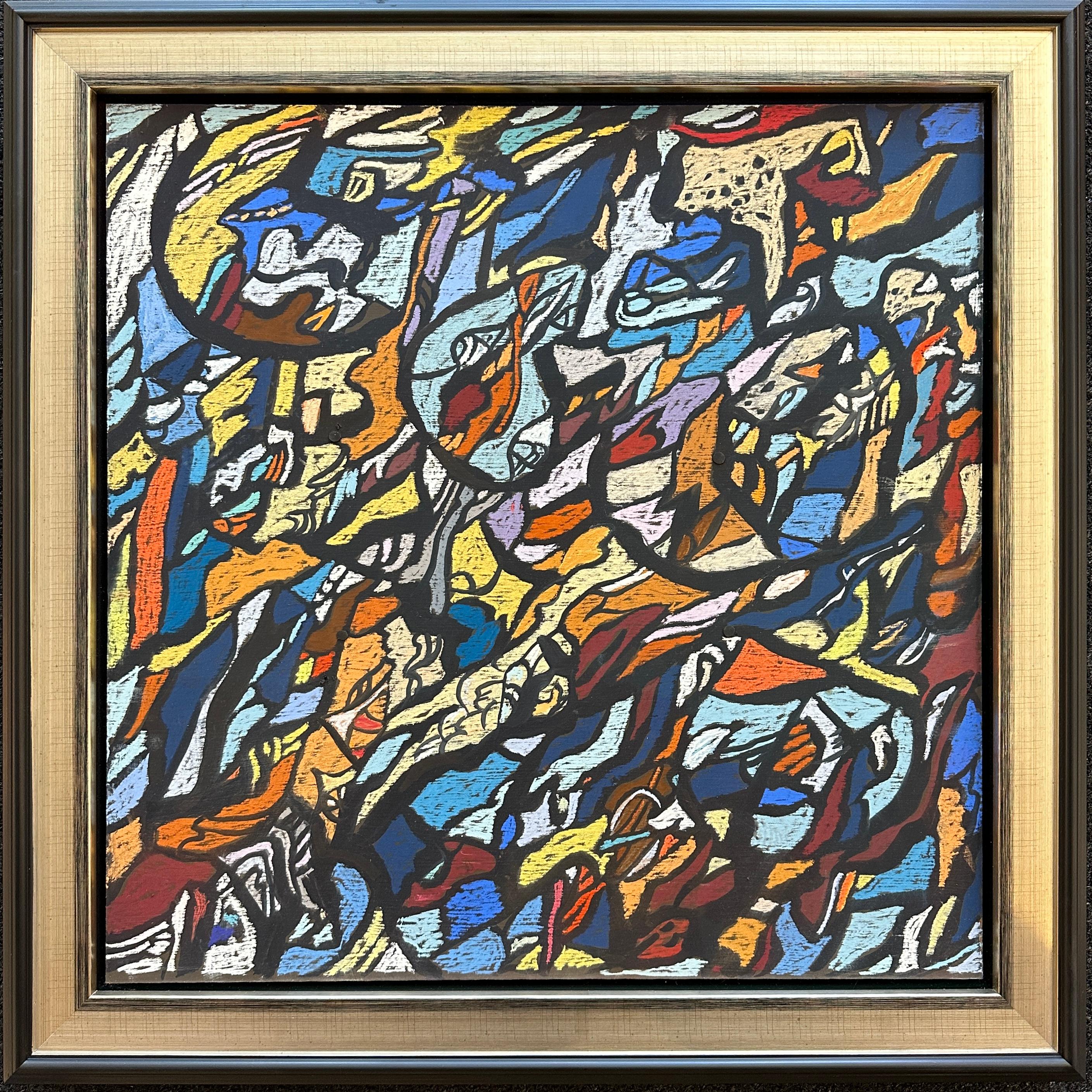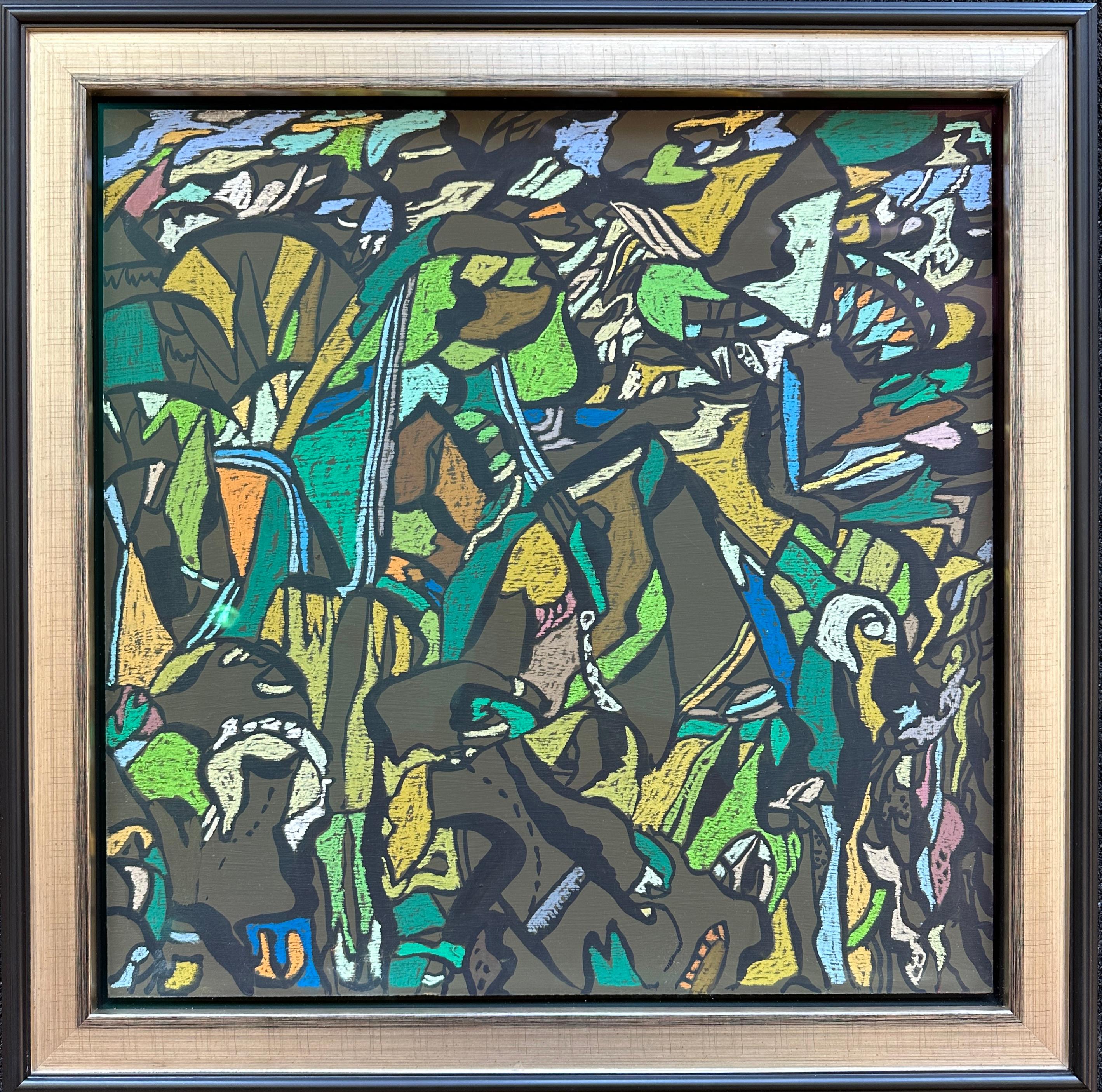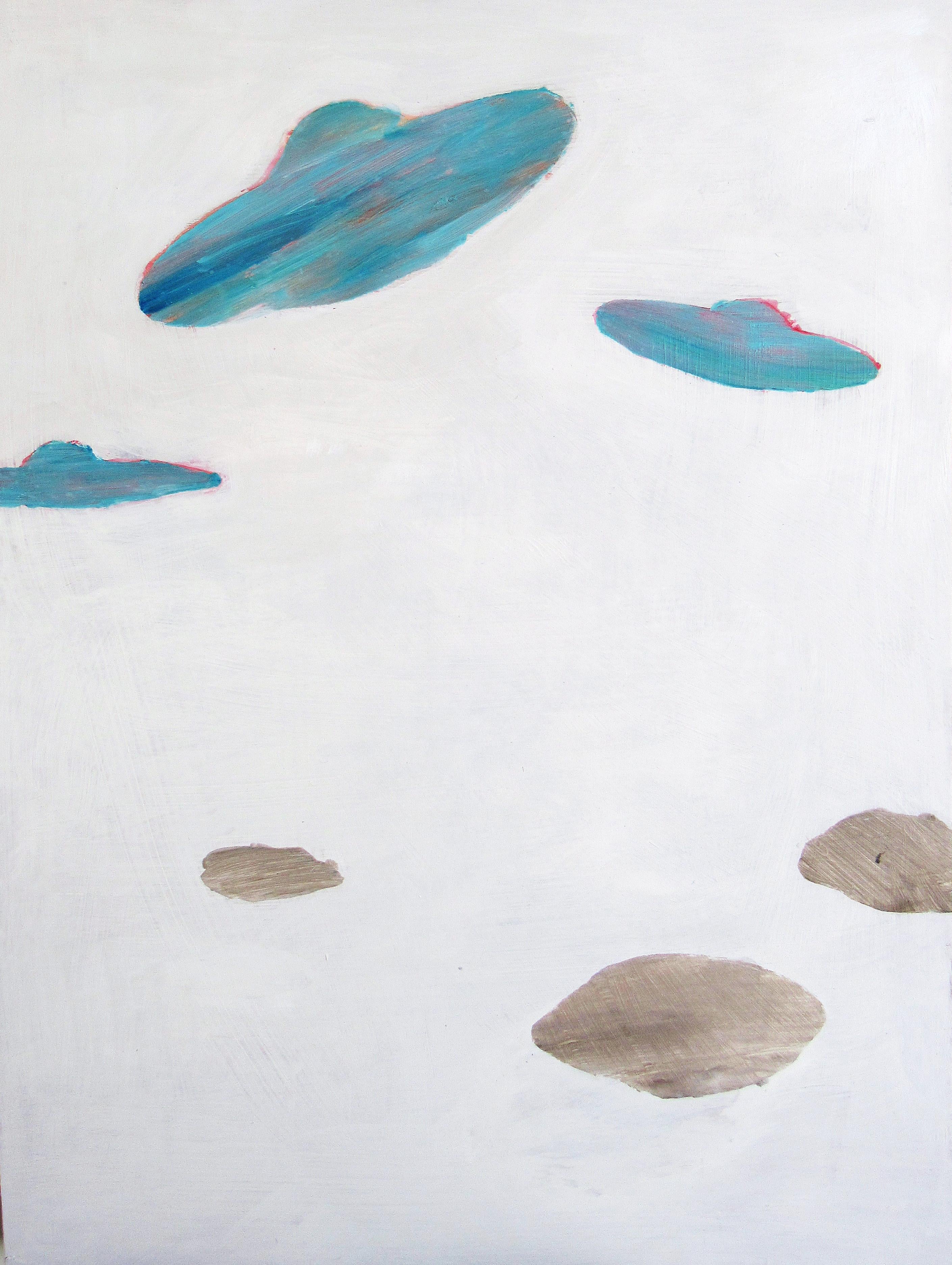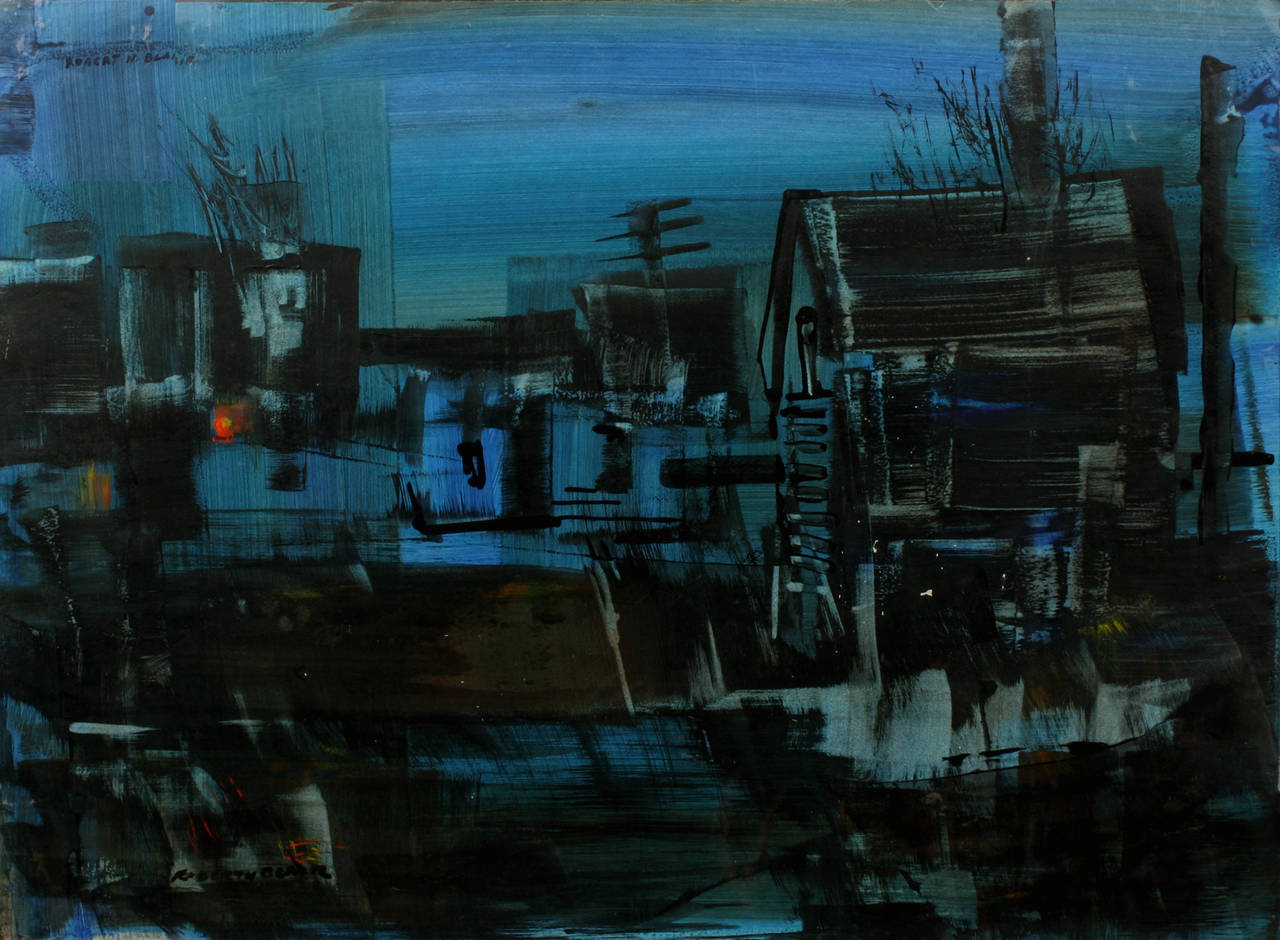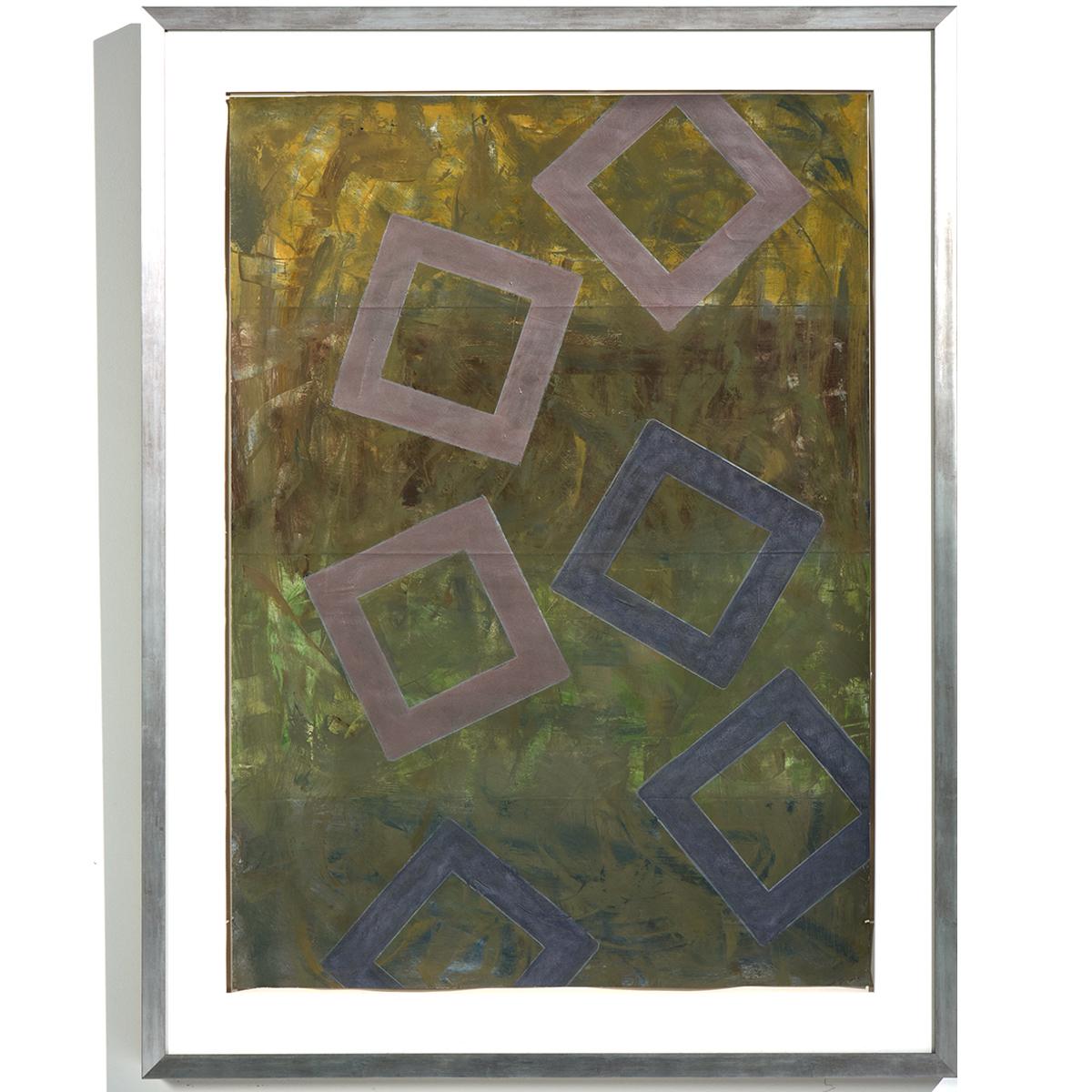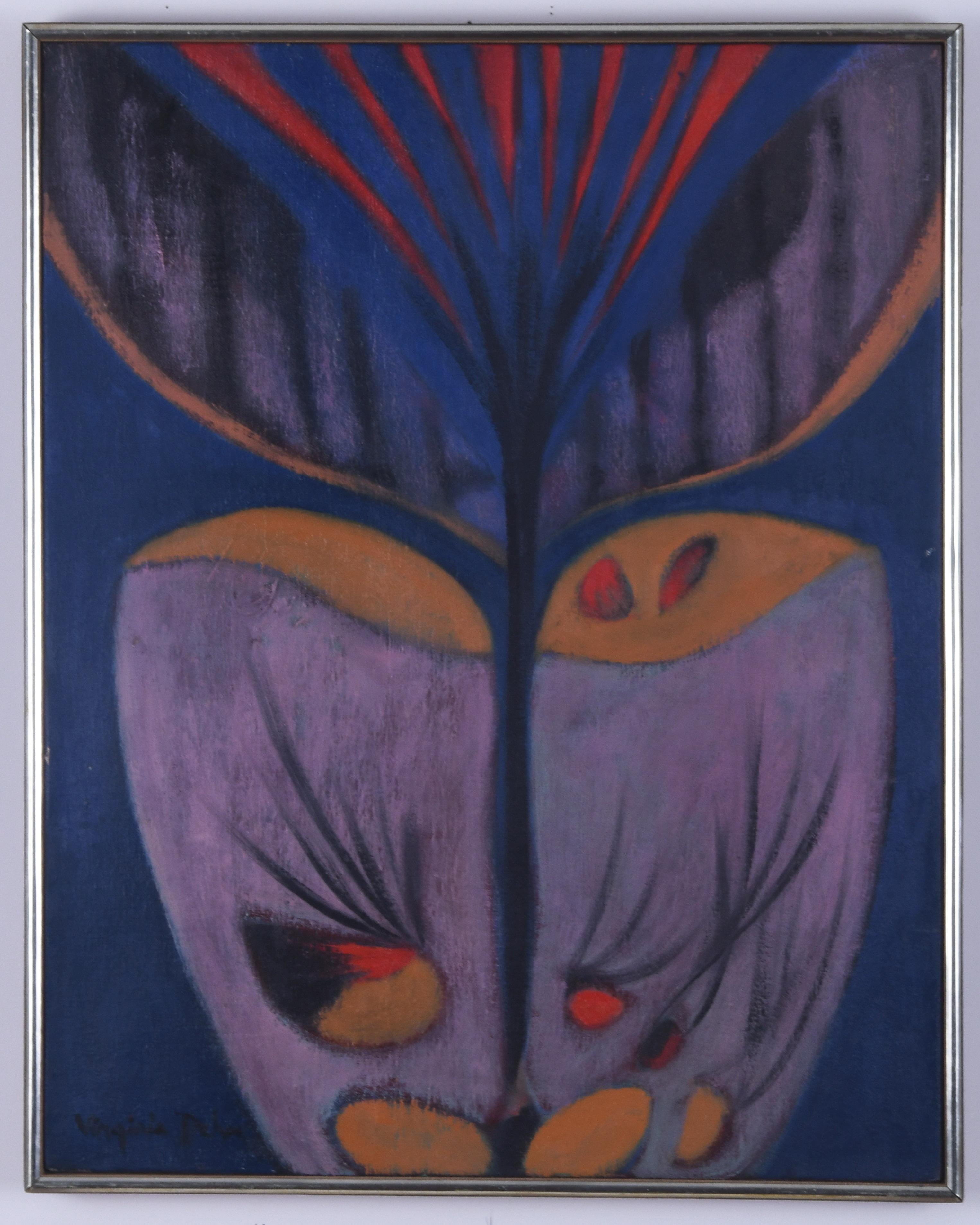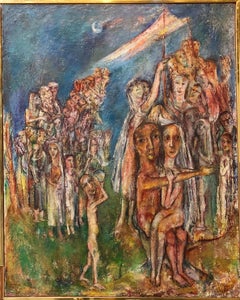
Vibrant Modernist Painting "Golden Square" 1963
View Similar Items
Want more images or videos?
Request additional images or videos from the seller
1 of 8
Kenneth ShopenVibrant Modernist Painting "Golden Square" 1963 1963
1963
About the Item
- Creator:Kenneth Shopen (1902-1967, American)
- Creation Year:1963
- Dimensions:Height: 32 in (81.28 cm)Width: 32 in (81.28 cm)
- Medium:
- Movement & Style:
- Period:
- Condition:
- Gallery Location:Surfside, FL
- Reference Number:Seller: 24361stDibs: LU3822290503
About the Seller
4.9
Platinum Seller
These expertly vetted sellers are 1stDibs' most experienced sellers and are rated highest by our customers.
Established in 1995
1stDibs seller since 2014
1,543 sales on 1stDibs
Typical response time: 1 hour
More From This SellerView All
- Large Trompe L'oeil Hyperrealism Painting Abstract Surrealist Photo Realist ArtLocated in Surfside, FLLarge acrylic painting by Pat Rosenstein, American Woman Artist, graduate of Pratt Institute whose work has been exhibited extensively. Rosenstein, who...Category
1990s American Modern Still-life Paintings
MaterialsCanvas, Acrylic
- Liberte, Egalite, Fraternite, Modernist PaintingBy Philippe VissonLocated in Surfside, FLPhilippe Visson, (1942-2008), whose parents were both of Russian origin, was born in New York in 1942. His mother, a Parisian art historian, was the Editor of La Gazette des Beaux-Arts from 1930 to 1960, and had always frequented the international artistic milieu. His father was a major political journalist for The Washington Post and Roving Editor for The Reader’s Digest. Philippe Visson therefore was raised in a cosmopolitan milieu between the United States and Europe. At the Vissons, one devours; one spends beyond one’s means; one falls, but only to land on one’s feet. Visson is a painter to whom it is difficult to assign a particular movement in art history; and that, principally for two reasons: firstly, his origins,his education and his way of life have produced a personality without any true roots, but rather a citizen of the world, who carries with him all cultures, from pre-Revolutionary Russia to the black ghetto of Washington, D.C. Secondly, he is self-taught, and can work in complete solitude, as well as before a large audience. His art is therefore uniquely his own, and certainly not that of an Art Brut ‘author’. His faces, his anti-portraits, reveal a continuum of humanity’s facets: from Christ to the demon, from the child to the aged, from the Caucasion to the African. Biography Philippe Visson, whose parents were both of Russian origin, was born in New York in 1942. His mother, a Parisian art historian, was the Editor of “The Gazette des Beaux-Arts” and had always frequented the international artistic milieu. His father was a major American political journalist for “The Washington Post” and “The Readers Digest”. Philippe Visson therefore was raised in a cosmopolitan milieu between the United States and Europe. He starts to paint in the bathroom of Parisian luxury hotel at the age of 16, working in a frenzy and without art lessons. He’s immediately confronted with the scrutiny of professional experts that surround his parents. He has instant success when he shows at the Craven Gallery in Paris in December, 1958, quickly offered to him; then in New York in the Milch Galleries in May, 1959; followed by shows in Monte Carlo, Geneva and New York again. It was too much, too soon. Visson falls into drinking. Returning to Washington, D.C. on 1960, the period 1963-1979 is differentiated by a life that is sometimes social, sometimes reclusive, which continues when his family settles in a large villa in Switzerland (Epalinges above Lausanne) in the mid-sixties. Visson has stopped drinking. He paints in one of the rooms of his parents’ house and inundates all the empty rooms with his productions that remain hidden from the public, allowing them to be seen only by personalities such as Marcel Brion and René Huyghe, both of the Académie Française; or Jean Leymarie, Director of the Museum of Modern Art in Paris. It’s only at the start of the seventies that he once again opens his work to the public. He meets several important cultural figures of the time, such as René Berger, Director of the State Fine Arts Museum of Lausanne; and Michel Thévoz, future Director of the Art brut Museum. After the death of his father in 1973, he settles without money with his mother in a luxury hotel in Paris. It’s only after a year and a half of perpetual and colorful adventures that they return to Washington, D.C., where he resumes painting and produces a unique period of abstracts. Returning to Switzerland at the death of his mother in the beginning of the eighties, Visson meets with blatant success in Switzerland, where institutions exhibit and purchase his paintings (Aarau State Fine Arts Museum, the Federal Office of Culture in Bern). His fury for painting takes the form of an explosion while remaining focused (he always keeps what he considers the best paintings for himself). After the life of a hermit in the Paccots, Visson comes down from his mountain to settle in Montreux on the Swiss Riveria. This moving is marked by a sort of return to social life, despite the fact that he paints in a cellar. A period of public projects with charitable goals is launched. Visson thrives on this contact with the public. This changes somewhat when he receives a working studio in The Montreux Palace in the late nineties. This emerging from the cellars denotes a new era for the artist. He starts an intense period of painting, and moves six thousand of his paintings to the Palace. He continues his public projects, including the acquisition against paintings of a Stradivarius violin...Category
Late 20th Century Modern Abstract Paintings
MaterialsAcrylic, Board
- Abstract Procession Jewish Wedding Chuppah Oil Painting Modernist JudaicaBy Sabina TeichmanLocated in Surfside, FLGenre: Modern Subject: Abstract Medium: Oil Surface: Canvas Country: United States Sabina Teichman: (1905-1983) Studied at Columbia Univ. (BA, MA), also with Charles J. Martin and A...Category
1950s American Modern Figurative Paintings
MaterialsCanvas, Oil
- Large Richard Merkin Painting Harlem Jazz Club, New Yorker Magazine Cover ArtistBy Richard MerkinLocated in Surfside, FLRichard Marshall Merkin (American, 1938-2009) Gladys and Half-Pint Hand signed 'Merkin' (center right), Titled, inscribed, dated, and initialed 'GLADYS BENTLEY AND FRANKIE 'HALF-PINT' JAXON 1997/R.M.' verso. Oil on canvas 37 1/2 x 72 in. (95.3 x 182.9 cm) framed 39 1/4 x 74 x 2 in. Gladys Alberta Bentley (August 12, 1907 – January 18, 1960) was an American blues singer, pianist, and entertainer during the Harlem Renaissance. Her career skyrocketed when she appeared at Harry Hansberry's Clam House, a well-known gay speakeasy in New York in the 1920s, as a black, lesbian, cross-dressing performer. She headlined in the early 1930s at Harlem's Ubangi Club, where she was backed up by a chorus line of drag queens. She dressed in men's clothes (including a signature tailcoat and top hat), played piano, and sang her own raunchy lyrics to popular tunes of the day in a deep, growling voice while flirting with women in the audience. On the decline of the Harlem speakeasies with the repeal of Prohibition, she relocated to southern California, where she was billed as "America's Greatest Sepia Piano Player" and the "Brown Bomber of Sophisticated Songs". She was frequently harassed for wearing men's clothing. She tried to continue her musical career but did not achieve as much success as she had had in the past. Bentley was openly lesbian early in her career, but during the McCarthy Era she started wearing dresses and married, claiming to have been "cured" by taking female hormones. Frankie "Half-Pint" Jaxon, born Frank Devera Jackson was an African American vaudeville singer, stage designer and comedian, popular in the 1920s and 1930s. He was born in Montgomery, Alabama, orphaned, and raised in Kansas City, Missouri. His nickname of "Half Pint" referred to his 5'2" height. He started in show business around 1910 as a singer in Kansas City, before travelling extensively with medicine shows in Texas, and then touring the eastern seaboard. His feminine voice and outrageous manner, often as a female impersonator, established him as a crowd favorite. By 1917 he had begun working regularly in Atlantic City, New Jersey and in Chicago, often with such performers as Bessie Smith and Ethel Waters, whose staging he helped design. He served slightly less than a year in the United States Army in 1918–1919 and rose to the rank of sergeant. In the late 1920s he sang with top jazz bands when they passed through Chicago, working with Bennie Moten, King Oliver, Freddie Keppard and others. He performed and recorded with the pianists Cow Cow Davenport, Tampa Red and "Georgia Tom" Dorsey, recording with the latter pair under the name of The Black Hillbillies. He also recorded with the Harlem Hamfats. In the 1930s, he was often on radio in the Chicago area, and led his own band, titled Frankie "Half Pint" Jaxon and His Quarts of Joy. Jaxon appeared with Duke Ellington in a film short titled Black and Tan (1929), and with Bessie Smith in "St. Louis Blues" (1929). Cab Calloway's "Minnie the Moocher" (1931) is based both musically and lyrically on Jaxon's "Willie the Weeper" (1927). Richard Merkin, Sometimes described as Rhode Island’s most famous New York artist, Richard Merkin has led a dual life for nearly 40 years - teaching at RISD while enjoying a celebrated painting career based in New York City. He has exhibited in countless gallery and museum shows in the US and abroad and is represented in the permanent collections of the Smithsonian Institution, The Museum of Modern Art, the Whitney Museum, the RISD museum and many others. In addition to contributing drawings and paintings to The New Yorker (along with, Art Spiegelman, Saul Steinberg, Harper’s, The New York Times Sunday Magazine and several books on Erotica and Baseball, he is a contributing editor for Vanity Fair and a former style columnist for GQ. Merkin’s honors include a Tiffany Foundation Fellowship and the Rosenthal Foundation Award from the American Academy of Arts and Letters. Museums and Selected Collections : The American Federation of Arts, New York, NY Brooklyn Museum, Brooklyn, NY Chrysler Museum of Art, Norfolk, VA First city Bank, Chicago, Ill Fisk University Art Gallery, Nashville, TN Hallmark Collections, Kansas City, MO Massachusetts Institute of Technology, Cambridge, MA Maimi-Dade Junior College, Miami, FL Michigan State University, East Lansing, MI Minnesota Museum of Art, Minneapolis, MN Museum of Modern Art, New York, NY Museum of Art, Rhode Island School of Design, RI McClung Museum, University of Tennessee, Knoxville, TN Pennsylvania Acadamy of the Arts, Philadelphia PA Prudential Insurance Company, Boston, Ma Prudential Insurance Company, Newark, NJ Rose Art Museum, Brandeis University, Waltham, MA Sara Robey Foundation, New York, NY Smithsonian Institution, Washington, DC State University of Brockport, Brockport, NY Whitney Museum of American Art, New York, NY Selected Publications : 1986-Present Contributing Editor, Vanity Fair ..1988-Present, New Yorker... 1988-Present, style column, GQ...1997, Text and Illustration for The Tijuana Bibles, published by Simon & Shuster, 1995, Illustrated book, Leagues Apart: the Men and Times of the Negro Baseball Leagues published by Morrow. 1967 Cover of the Beatles “Sgt. Peppers Lonely Hearts Club Band” Album (Mr. Merkin appears in the back row, right of center) RISD: MFA in Painting, 1963; Professor, Department of Painting special skill: Merging his role as flaneur (connoisseur of city life) with his role as painter and social historian, Merkin retrieves lost cultural artifacts – a Turkish cigarette, a gangster, a bowler and generally “things most people don’t know about” – and reconstitutes their Jazz Age virtues on canvas in cubist, comic-laced landscapes of tropical color. (ala Robert Crumb and Ben Katchor) breaking in: Perpetually on the fly from his middle-class Brooklyn background, Merkin found the perfect escape in the mid ‘60s in George Frazier, a dapper Boston columnist who inspired the emerging New York painter’s overnight reinvention of himself. The elements of structure, stability and surprise he admired in this well-dressed dandy – a cool linen suit, a splash of suspender, a polka dot scarf and pearl-handled walking stick – soon surfaced in paintings peopled by impeccable underdogs of café society along with his personal pop heroes: William Burroughs, Bobby Short and Krazy Kat...Category
1990s American Modern Abstract Paintings
MaterialsCanvas, Oil Pastel, Oil
- Modernist Abstract Expressionist Watercolor Painting Bauhaus Weimar ArtistBy Pawel KontnyLocated in Surfside, FLAbstract watercolor composition bearing the influence of the earlier color-block compositions of Paul Klee. Pawel August Kontny, (Polish-German-American artist) He was born in Laurahuette, Poland, in 1923, the son of a wealthy pastry shop owner. In 1939 he began studying architecture in Breslau where he was introduced to the European masters and to the work of some of the German Expressionists, soon afterward banned as "degenerate artists" and removed from museums throughout Germany by the Nazi regime. His studies were interrupted by World War II. Drafted into the German army, traveling in many countries as a soldier, he sketched various landscapes but in 1945, he was captured and held as a prisoner of war in Italy. After the war, he studied at the Union of Nuremberg Architects to help design buildings to replace ones destroyed in the war. He recorded his impressions of the local population and the landscapes through his watercolors and drawings. Pawel Kontny thereafter moved to Nuremberg, Germany, becoming a member of the Union of Nuremberg Architects and helping to rebuild the city's historic center. He soon decided to concentrate on his professional art career. He married Irmgard Laurer, a dancer with the Nuremberg Opera. Pavel Kontny 's career as an artist was launched with his participation in an all German exhibition, held at the Dusseldorf Museum in 1952. He held one-man shows in Germany, Switzerland and the United States. During his trip to the United States in 1960, Kontny became instantly enamored with Colorado, and decided to relocate to Cherry Hills with his wife and two children. He quickly established himself in the local art community, being affiliated for a time with Denver Art Galleries and Saks Galleries. His subject matter became the Southwest. During this time he received the Prestigious Gold Medal of the Art Academy of Rome. His extensive travel provided material for the paintings he did using his hallmark marble dust technique. he also worked equally in pastel, watercolor, charcoal and pencil-and-ink. in a style which merged abstraction and realist styles, influenced by Abstract Expressionist painting and South Western American landscapes. In the early 1960s he was one of only a few European-born professional artists in the state, a select group that included Herbert Bayer (1900-1985), a member of the prewar Bauhaus in Weimar and Dessau, Germany, and Roland Detre (1903-2001), a Hungarian modernist painter. As a Denver, Colorado resident, Pavel Kontny exhibited at galleries and museums throughout the United States, Germany and Japan. There, he was inspired by frequent trips to Native American pueblos in the Southwest, as well as by the study of the Plains Indians of Montana and Wyoming. Over the years Kontny had a number of students and generously helped young artist by hosting exhibitions at his Cherry Hills home. For many years he generously donated his paintings to support charitable causes in Denver. Influences during his European years included German pastelist C.O. Muller, German Informel painter Karl Dahmen and Swiss artist, Hans Erni. In the early 1950s his painting style showed the influence of the Die Brücke (The Bridge), a group of German expressionist artists formed in Dresden in 1905 who had a major impact on the evolution of modern art in the twentieth century in Germany. By the middle of the decade his style incorporated more referential abstraction and total abstraction, resulting in part from his study of Hans Hartung, a German artist based in Paris who exhibited his gestural abstract work in Germany. His work also bears the influence of Sam Francis. The American moon landing in 1969 inspired Paul Kontny...Category
Mid-20th Century American Modern Abstract Drawings and Watercolors
MaterialsWatercolor, Archival Paper
- Large Archie Rand Abstract Expressionist Cartoon Oil Painting DusseldorfBy Archie RandLocated in Surfside, FL"Dusseldorf, Germany" 1993, oil on canvas, hand signed and dated lower left, Canvas (unframed):18 X 48. framed: 19.5 X 49.5 Provenance: directly from the artist. Exhibited at Phyllis Kind Gallery in NYC in 1987. Archie Rand (American, born 1949) is an artist from Brooklyn, New York. Rand's work as a painter and muralist is held in the collections of the San Francisco Museum of Modern Art, the Art Institute of Chicago, the Victoria and Albert Museum in London, the Bibliothèque Nationale de France in Paris, and the Tel Aviv Museum of Art. His graphic works and books are held by the Metropolitan Museum Of Art, the Museum of Modern Art, the Whitney Museum of American Art, the Art Institute Of Chicago, The Brooklyn Museum, the Baltimore Museum of Art, the Smithsonian Institution, and The New York Public Library; and are owned by Harvard, Yale, Columbia, Brown, and Johns Hopkins universities. Born in Brooklyn, Rand received a Bachelor of Fine Arts in cinegraphics from the Pratt Institute, having studied previously at the Art Students League of New York. His first exhibition was in 1966, at the Tibor de Nagy Gallery in New York. He has since had over 100 solo exhibitions, and his work has been included in over 200 group exhibitions. He is currently Presidential Professor of Art at Brooklyn College which granted him the Award for Excellence in Creative Achievement in 2016. Before joining Brooklyn College, Rand was the chair of the Department of Visual Arts at Columbia University. The Italian Academy For Advanced Studies in America at Columbia University presented him with The Siena Prize in 1995. He was awarded a Guggenheim Foundation Foundation Fellowship in 1999 and was made a Laureate of the National Foundation for Jewish Culture, which awarded him the Achievement Medal for Contributions in the Visual Arts. In 2002 he received the Presidential Award for Excellence in Teaching from Columbia University. In 2002 he became the artistic advisor to film director Ang Lee for his production of The Hulk, and was asked by Milestone Films to provide a commentary track for the DVD release of Henri-Georges Clouzot’s classic 1955 film The Mystery of Picasso. Archie Rand’s earliest major works are “The Letter Paintings” (or “The Jazz Paintings”) (1968–71), a radically positioned series of technically inventive, mural-sized canvases. The Letter Paintings, by incorporating the names of mainly male and female African-American musicians, undermined prevailing aesthetic categories by conflating many contemporary movements including Conceptual Art, Color Field, Pattern and Decoration, diary entry and social commentary. In 1974 Rand received a commission from Congregation B’nai Yosef in Brooklyn. Rand was asked to paint thematic murals on the complete 16,000-square-foot (1,500 m2) interior surfaces of the synagogue. The work took three years, and completing this commission made Rand the author of the only narratively painted synagogue in the world and the only one we know of since the 2nd Century Dura-Europos. The religious legal controversy raised by placing wall paintings in a traditionally iconoclastic space was resolved by the verdict of Rabbi Moshe Feinstein, then considered to be the world’s leading Talmudic scholar, who declared the paintings to be in conformity with the law. His subsequent turn to figuration may have been influenced by his friendship with Philip Guston, whose own work was transformed in the late 1960s. Like Guston, Rand "chafed at the limitations of purely abstract forms." A near-cult figure who started out as a child prodigy and whose admirers range from John Ashbery to Julian Schnabel. Rand’s paintings display a vast and savvy menu of inventive and finely executed approaches. He has completed many series after the works of Paul Celan, Moyshe-Leyb Halpern, Eugenio Montale, Yehuda Amichai, Rainer Maria Rilke, Samuel Beckett/Paul Eluard and Jack Spicer. Working often with poets, he has produced books and continues to engage in publishing collaborative projects. He maintained a correspondence with the American British Jewish painter R.B. Kitaj. In 2008, on a warehouse wall, Rand mounted the painting, “The 613”, which at 1700 square feet (17’ x 100’) is nearly twice the size of James Rosenquist’s F-111. It is one of the largest freestanding paintings ever made. Reminiscent of “The Segments” paintings it is intimidatingly enormous. Paradoxically, despite the raucous cartoony bytes that shoot colorful flashes from the manic surface, “The 613” glows warmly. Its overall effect is strangely calming and majestic. In an article on a 2011 exhibition of Rand's "Had Gadya" series, David Kaufmann wrote: Rand displayed his work in 15 solo exhibitions between 2008 and 2017, many of them showcasing paintings done after Scripture, or his workings with poets: Including “Had Gadya, 2005”, Borowsky Gallery, Philadelphia, PA (2011); “Gods Change, Prayers Are Here To Stay (after Yehuda Amichai), 2000", Katz Gallery, Atlanta, GA (2014); “Psalm 68, 1994”, Derfner Museum, Riverdale, NY (2014); “The Chapter Paintings”, Tribeca Gallery, NY (2015); “Men Who Turn Back (after Eugenio Montale), 1995", SRO Gallery, Brooklyn, NY (2016); “Sixty Paintings From the Bible” & “The Book of Judith, 2012”, Cleveland State University Galleries, Cleveland, OH (2016) & The American Jewish Museum, Pittsburgh, PA (2017); “Archie Rand: Early Works With Poetry: Jack Spicer, 1991 and Samuel Beckett/Paul Eluard, 1993”, St. Francis College, Brooklyn, NY (2017). "The 613" In 2015 Blue Rider/Penguin/Random House published The 613, allotting one color plate per page for each of the 614 units in the painting. The Wall Street Journal labeled The 613 as “dynamic…remarkable…thrilling” The New York Times selected the book as “Editors' Choice” and praised it in two separate reviews calling it “wonderfully garish” and declaring that “nothing prepared the art world for 'The 613.' Recent Activity In 2016 Rand showed two bodies of work that were done in Italy, “La Certosa Di Pontignano, 1995” and “Mount Etna, 2005,” at The Interchurch Center Galleries, New York. From 2016 to 2017 he served as the Curator and Juror for the Governor of Wyoming’s Capitol Arts Exhibition at The Wyoming State Museum, Cheyenne, WY. A 2017 exhibition, “Archie Rand: Early Works With Poetry”, featured two series of work from 1991 and 1993 after poems by Jack Spicer and Samuel Beckett/Paul Eluard. This painting was exhibited in the Phyllis Kind Gallery in NY in 1987. (Phyllis Kind was an American art dealer active in Chicago and New York. She promoted the work of the Chicago Imagists, The Monster Roster and The Hairy Who and outsider artists. Kind opened a gallery in Chicago in 1967. Called Pro Grafica Arte, the gallery dealt in master prints and drawings. In 1975, she opened a gallery on Spring Street in New York's SoHo district. She gave some of the artists in the movement their first solo shows: Jim Nutt and Gladys Nilsson...Category
1980s American Modern Figurative Paintings
MaterialsCanvas, Oil
You May Also Like
- Johnny Hodges - The Big Sound (Grammy, Album Art, Iconic, Rock and Roll, Pop)By Kerry SmithLocated in Kansas City, MOKerry Smith Johnny Hodges - The Big Sound Mixed Media on Crescent board Year: 2016 Size: 21x20in Signed, dated by hand COA provided Ref.: 91-0194 ----------------------------------...Category
2010s American Modern Figurative Paintings
MaterialsMixed Media, Acrylic, Gouache, Board
- R.E.M. - Murmur (Grammy, Album Art, Iconic, Rock and Roll, Pop, Legendary)By Kerry SmithLocated in Kansas City, MOKerry Smith R.E.M. - Murmur Mixed Media on Crescent board Year: 2022 Size: 21x20in Signed, dated by hand COA provided Ref.: 924802-1633 --------------------------------------- "Of...Category
2010s American Modern Figurative Paintings
MaterialsAcrylic, Gouache, Board, Mixed Media
- Golfer Swinging, Vintage 7 Up Ad "Get Real Action" in Green and Yellow - GolfBy Bob PeakLocated in Miami, FLThis strobe-like dynamic composition with bright and bold colors reflects the energetic taste of the 7 Up brand. It lies somewhere between abstraction and figuration. Peaks' use of b...Category
1960s American Modern Figurative Paintings
MaterialsAcrylic, Illustration Board
- Led Zeppelin - Houses Of The Holy (Grammy, Album Art, Iconic, Rock and Roll)By Kerry SmithLocated in Kansas City, MOKerry Smith Led Zeppelin - Houses Of The Holy Mixed Media on Crescent board Year: 2018 Size: 21x20in Signed, dated by hand COA provided Ref.: 924802-1632 --------------------------...Category
2010s American Modern Figurative Paintings
MaterialsMixed Media, Acrylic, Gouache, Board
- Untitled 006 abstract painting by Fred MartinBy Fred MartinLocated in Hudson, NYExhibited: 2003 Oakland Museum of California "Fred Martin Retrospective" A native Californian, Fred Martin was born in San Francisco in 1927, and received both his BA (1949) and MA (1954) from University of California, Berkley. At the San Francisco Art Institute Martin studied with Clyfford Still, Mark Rothko and David Park...Category
1970s American Modern Abstract Paintings
MaterialsMasonite, Pastel, Acrylic
- Over Isfahan by Fred MartinBy Fred MartinLocated in Hudson, NYIn the summer of 1970, I had been using acrylic for four years and had yet to find a way to develop color like a composer might orchestrate a symphony from a piano score. (The symphonic was then my visual ideal.) After the 106th acrylic of “majestic” size, I got real about scale—smaller—and switched to colored sticks of soft pastel so I could hold a rainbow in my hand. I kept on with the streaming lines of the big acrylic paintings, but I filled the spaces between with the soft pastels. –Fred Martin...Category
1970s American Modern Abstract Paintings
MaterialsMasonite, Pastel, Acrylic


